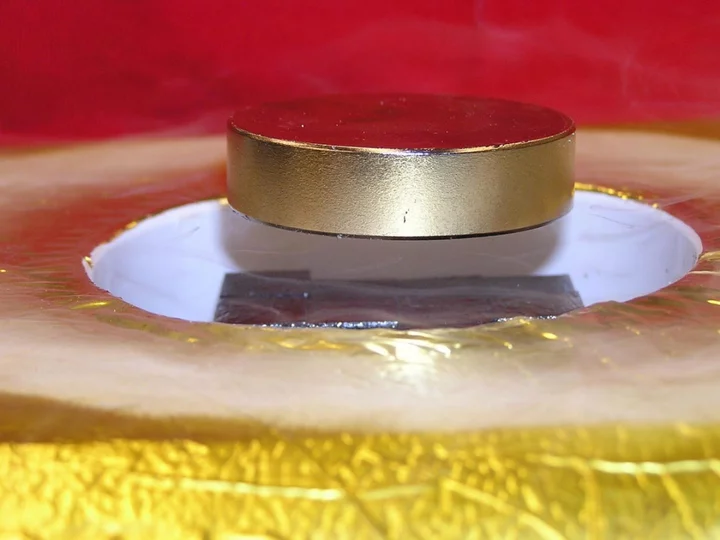Odd ‘demon’ particle found inside superconductor may help demystify ‘holy grail’ of physics
Scientists have finally found a “demon” subatomic particle that was predicted to exist nearly seven decades ago and speculated to play an important role in the behaviours of a range of metals and alloys, including superconductors. Physcist David Pines in 1956 theorised that electrons, which normally have a mass and negative electric charge, can under some conditions combine to form a composite “demon” particle that is massless, neutral and does not interact with light. These theorised interesting properties, however, made these particles elude detection – until now. After a nearly 70-year search for these subatomic entities, researchers, including those from the University of Illinois Urbana-Champaign, have finally found signatures of Dr Pines’ “demon” particles in the metal strontium ruthenate. “Demons have been theoretically conjectured for a long time, but experimentalists never studied them. In fact, we weren’t even looking for it. But it turned out we were doing exactly the right thing, and we found it,” study co-author Peter Abbamonte said. Electrons – which are distributed in different energy bands within atoms – are known to lose their individuality in solids with electric interactions making the particles combine to form collective units. With some threshold energy, studies have also shown electrons can form composite particles called plasmons with a new charge and mass. However, the mass is so large that these plasmon particles cannot form with the kind of energies available at room temperature. Revelations on room-temperature semiconductors are considered to be one of the “holy grails” of physics. But Dr Pines theorised that if a solid has electrons in more than one energy band, as many metals do, their respective plasmons may combine in an out-of-phase pattern to form a new plasmon that is massless and neutral – a demon. Since these special particles are massless, he argued they can form with any energy and may exist at all temperatures – leading to speculation that the demons have important effects on the behaviour of some metals with multiple energy bands. “The vast majority of experiments are done with light and measure optical properties, but being electrically neutral means that demons don’t interact with light,” Dr Abbamonte explained. So a completely new experiment was needed to detect them. In the research, scientists were studying the compound strontium ruthenate as it is similar to high-temperature superconductors – a special kind of material where electrical resistance vanishes. For a survey of the metal’s electronic properties, they synthesised high-quality samples of the metal. They then applied a technique to study the metal that uses energy from electrons shot into the metal to directly observe the metal’s features, including plasmons that form. During their observation of the electron interactions, scientists found something unusual – an electronic mode with no mass. “At first, we had no idea what it was. Demons are not in the mainstream. The possibility came up early on, and we basically laughed it off. But, as we started ruling things out, we started to suspect that we had really found the demon,” Ali Husain, another author of the study, said. Researchers then sought to calculate how electrons are distributed across bands inside strontium ruthenate. Predictions by Dr Pines indicate there are specific conditions when “demons” are likely to form, and it remained unknown whether strontium ruthenate would have the particle. “We had to perform a microscopic calculation to clarify what was going on. When we did this, we found a particle consisting of two electron bands oscillating out-of-phase with nearly equal magnitude, just like Pines described,” found Edwin Huang, another author of the study. “Our study confirms a 67-year-old prediction and indicates that demons may be a pervasive feature of multiband metals,” scientists wrote in the study. Read More Superconductor breakthrough could represent ‘biggest physics discovery of a lifetime’ – but scientists urge caution LK-99: Excitement rises over possibly revolutionary ‘miracle material’ – but there is still no good reason to believe it exists Superconductivity: The technology that could change everything if we just knew how it worked ‘Vampire child’ with padlocked ankle unearthed in Polish ‘necropolis’ Two new kinds of mole discovered in mountains of Turkey Scientific discovery casts doubt on our understanding of human evolution
Scientists have finally found a “demon” subatomic particle that was predicted to exist nearly seven decades ago and speculated to play an important role in the behaviours of a range of metals and alloys, including superconductors.
Physcist David Pines in 1956 theorised that electrons, which normally have a mass and negative electric charge, can under some conditions combine to form a composite “demon” particle that is massless, neutral and does not interact with light.
These theorised interesting properties, however, made these particles elude detection – until now.
After a nearly 70-year search for these subatomic entities, researchers, including those from the University of Illinois Urbana-Champaign, have finally found signatures of Dr Pines’ “demon” particles in the metal strontium ruthenate.
“Demons have been theoretically conjectured for a long time, but experimentalists never studied them. In fact, we weren’t even looking for it. But it turned out we were doing exactly the right thing, and we found it,” study co-author Peter Abbamonte said.
Electrons – which are distributed in different energy bands within atoms – are known to lose their individuality in solids with electric interactions making the particles combine to form collective units.
With some threshold energy, studies have also shown electrons can form composite particles called plasmons with a new charge and mass.
However, the mass is so large that these plasmon particles cannot form with the kind of energies available at room temperature. Revelations on room-temperature semiconductors are considered to be one of the “holy grails” of physics.
But Dr Pines theorised that if a solid has electrons in more than one energy band, as many metals do, their respective plasmons may combine in an out-of-phase pattern to form a new plasmon that is massless and neutral – a demon.
Since these special particles are massless, he argued they can form with any energy and may exist at all temperatures – leading to speculation that the demons have important effects on the behaviour of some metals with multiple energy bands.
“The vast majority of experiments are done with light and measure optical properties, but being electrically neutral means that demons don’t interact with light,” Dr Abbamonte explained.
So a completely new experiment was needed to detect them.
In the research, scientists were studying the compound strontium ruthenate as it is similar to high-temperature superconductors – a special kind of material where electrical resistance vanishes.
For a survey of the metal’s electronic properties, they synthesised high-quality samples of the metal.
They then applied a technique to study the metal that uses energy from electrons shot into the metal to directly observe the metal’s features, including plasmons that form.
During their observation of the electron interactions, scientists found something unusual – an electronic mode with no mass.
“At first, we had no idea what it was. Demons are not in the mainstream. The possibility came up early on, and we basically laughed it off. But, as we started ruling things out, we started to suspect that we had really found the demon,” Ali Husain, another author of the study, said.
Researchers then sought to calculate how electrons are distributed across bands inside strontium ruthenate.
Predictions by Dr Pines indicate there are specific conditions when “demons” are likely to form, and it remained unknown whether strontium ruthenate would have the particle.
“We had to perform a microscopic calculation to clarify what was going on. When we did this, we found a particle consisting of two electron bands oscillating out-of-phase with nearly equal magnitude, just like Pines described,” found Edwin Huang, another author of the study.
“Our study confirms a 67-year-old prediction and indicates that demons may be a pervasive feature of multiband metals,” scientists wrote in the study.
Read More
Superconductor breakthrough could represent ‘biggest physics discovery of a lifetime’ – but scientists urge caution
LK-99: Excitement rises over possibly revolutionary ‘miracle material’ – but there is still no good reason to believe it exists
Superconductivity: The technology that could change everything if we just knew how it worked
‘Vampire child’ with padlocked ankle unearthed in Polish ‘necropolis’
Two new kinds of mole discovered in mountains of Turkey
Scientific discovery casts doubt on our understanding of human evolution









